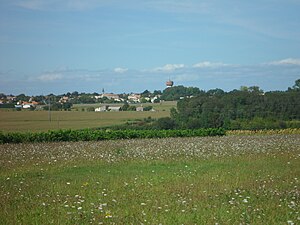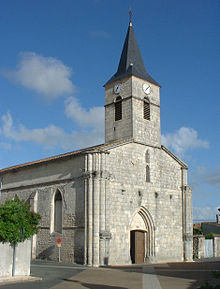Arvert
| Arvert | ||
|---|---|---|
|
|
||
| region | Nouvelle-Aquitaine | |
| Department | Charente-Maritime | |
| Arrondissement | Rochefort | |
| Canton | La Tremblade | |
| Community association | Royan Atlantique | |
| Coordinates | 45 ° 45 ′ N , 1 ° 8 ′ W | |
| height | 0-25 m | |
| surface | 26.22 km 2 | |
| Residents | 3,448 (January 1, 2017) | |
| Population density | 132 inhabitants / km 2 | |
| Post Code | 17530 | |
| INSEE code | 17021 | |
| Website | www.arvert.fr | |
 Arvert - the site |
||
Arvert is a southwestern French community with 3,448 inhabitants (at January 1, 2017) in the department of Charente-Maritime in the region Nouvelle-Aquitaine .
location
Arvert is located on the peninsula of the same name between Gironde and Seudre , about 18 kilometers (driving distance) north of Royan , which is part of the historic cultural landscape of the Saintonge .
Population development
| year | 1800 | 1851 | 1901 | 1954 | 1999 | 2013 |
| Residents | 2,717 | 2,539 | 2,494 | 2.003 | 2,887 | 3,329 |
As a result of the mechanization of agriculture , the population from the 1920s to the 1960s was only around 2,000.
economy
Agriculture has played a dominant role in the municipality's economic life for centuries. This is one of the Bons Bois of the Cognac wine-growing region , but because of the crisis in sales of brandies and even wine, vines are rarely planted. Many farmers have returned to 'normal' agriculture. Tourism has played a not insignificant role in the economic life of the place since the 1980s. Other sources of income in the Avallon district are fishing and oyster farming.
history
Prehistoric and Gallo-Roman finds have been made in the municipality . In the Middle Ages, monks founded a small monastic community here. Arvert survived the Hundred Years War (1337-1453) unscathed, but the Romanesque church was badly damaged in the French Wars of Religion (1562-1598), which raged particularly in western France. With the edict of Nantes issued by Henry IV in 1598, the situation calmed down, but after the murder of the king (1610) new hostilities flared up between Catholics and Protestants , so that Louis XIII. and his First Minister Richelieu felt compelled to intervene, which in the siege and capture of La Rochelle culminated. In 1644 the Protestant cult in Arvert was banned and in 1682 Louis XIV ordered the demolition of the Protestant temple . After the Edict of Fontainebleau was issued (1685), which repealed the Edict of Nantes, many Protestants emigrated to other European countries or to the American New France . The Protestant faith, however, lived on in the underground - the believers met in secret in the dunes or in barns; there was talk of a 'church in the desert' ( Église du Desert ). It was not until the marshal and governor Jean Charles de Saint-Nectaire , who was tolerant in religious matters , that the situation improved for the Protestants in the middle of the 18th century.
Attractions
See also: List of Monuments historiques in Arvert
- After the destruction during the Huguenot Wars, only remnants of the rising masonry remain from the Romanesque church; the appearance of the current church is essentially from 1685: the unadorned facade is framed by side bundles of services , as can be seen in many churches in Poitou and Saintonge; Above the portal there are still the remains of a partially figurative console frieze that belonged to the previous building - on the other hand the tower top is an ingredient of the 19th century. The single-nave interior of the church received a flat barrel vault made of plaster , which was applied to a wooden ceiling paneling; During a renewed restoration in the 20th century, the plaster was removed from the walls made of rubble stones, creating an attractive contrast between the outer walls and the vault. A small gem in the otherwise unadorned church is the stone baroque pulpit .
- In the square in front of the church there is a baroque fountain, the shaft of which is covered by a small dome with a lantern top.
- The first Protestant church from 1566 was replaced by a second church in 1609, which was torn down in 1682 to rebuild the Catholic Church of Saint-Étienne with the stones. In 1755 a house in the Avallon district was converted into a house of prayer ( maison d'oraison ). The current Protestant 'temple' dates from 1834 and has been restored several times afterwards; like many Protestant houses of worship, it convinces with its unadorned severity and simplicity of architecture.
- In the 19th century there were around 20 windmills in the municipality, which have now almost completely disappeared - of some only the tower stumps can be seen.
literature
- Le Patrimoine des Communes de la Charente-Maritime. Flohic Editions, Volume 2, Paris 2002, ISBN 2-84234-129-5 , pp. 1135-1137.

